Analysis: What's Really Driving the Trade Deficit With China

President Donald Trump has warned that discussions with his Chinese counterpart ,Xi Jinping, in Florida this week will be "very difficult," in large part because of disagreements over trade. But before Trump can shrink America's lopsided trade deficits — with China or anyone else — he first must recognize what's driving them.
Unlike in the past, most deficits today have little to do with currency manipulation or unfair tariffs. In the 19th century, import tariffs were the main instrument of trade intervention, increasingly supplemented during the 1920s and 1930s by currency machinations.
This continued well into the 20th century. Even as international agreements — usually championed by the United States — began to restrict the use of tariffs in the post-Bretton-Woods era, Europe and Japan, taking advantage of Cold War exigencies, protected domestic industries for decades by keeping their currencies undervalued relative to the dollar.
During this time, trade imbalances mostly were determined by direct differences in the cost of traded goods, while capital flowed from one country to another mainly to balance trade flows.
Today, however, conditions have changed dramatically. Capital flows dwarf trade flows, and investment decisions by fund managers determine their direction and size.
This has profound implications for trade. Large, persistent trade surpluses such as the one China runs with the United States no longer are the consequence of explicitly mercantilist measures. Instead, they're driven by policies that distort domestic savings rates by subsidizing production at the expense of households.
Take Germany, for example. After a decade of trade deficits and high unemployment, worried leaders in Berlin implemented labor reforms in 2003-05 whose main effect was to weaken wage growth. As unemployment dropped and business profits surged, the reforms also shrunk the share of national income allocated to ordinary households, driving down the consumption share as well.
German businesses, blessed with higher profits, responded unhelpfully. They paid down debt instead of investing the profits, increasing the share of national income devoted to savings. As the growing gap between German savings and investment soon became among the largest in history, so did the German trade surplus.
German banks exported the excess savings into other European countries, no longer protected by the interest-rate and currency adjustments proscribed under the rules of the euro. By 2009, after insolvency prevented one European country after another from absorbing any more of the German tsunami of capital outflows, these shifted to countries outside Europe.
While the experiences of China and Japan may seem different on the surface, they were broadly similar in impact. China, for example, severely repressed interest rates in order to boost growth. This simultaneously reduced the household share of Chinese GDP to among the lowest ever recorded and raised Chinese savings to among the highest — so high that, even with the fastest-rising investment in the world, China still needed large trade surpluses to make up for weak domestic demand.
What happens next is the most confusing part for economists who don’t understand how trade has changed. When new capital pours into advanced economies that have always had easy access to investment — such as the United States and southern Europe — it doesn't boost investment further. Instead, it automatically causes savings to contract.
There are many ways this can happen. Capital inflows might raise the real exchange rate, which reduces savings by increasing household purchasing power. Inflows also can also lower interest rates and weaken credit standards, both of which encourage high-flying households to fund consumption binges. They can set off wealth effects, as foreign money pours into real estate and leaves households suddenly feeling richer. They can raise unemployment, forcing workers to dig into savings.
These automatic adjustments, and many others, force down savings rates in the capital-receiving countries. With its deep and flexible capital markets and dominant reserve currency status, the United States is especially vulnerable. It is the only country able to absorb large amounts of foreign capital, currently taking in nearly half of the world’s excess savings.
As counterintuitive as it may seem, if Trump wants to address the U.S. trade deficit with China, he must focus on the capital account, not the trade account. Instead of imposing tariffs, he should either implement policies that absorb foreign savings more productively into the United States, say by exploiting historically low interest rates and investing in much-needed infrastructure whose economic benefits are too diffuse to be captured by the private sector. Or his administration should change the way savings imbalances are transmitted into the United States, for example by taxing capital flows, which the United States was doing as recently as the 1960s.
What Trump shouldn't do is get involved in a tit-for-tat tariff war with China that sidesteps the real sources of the imbalances. In a world in which capital flows overwhelm trade flows, trade imbalances are driven by imbalances in global savings, and the United States cannot resolve the former without addressing the latter. Nothing he and Xi discuss this week will change that fact.




